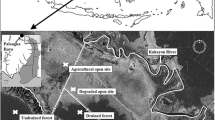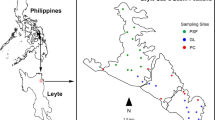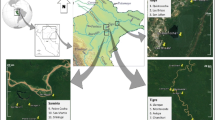Abstract
Peatlands act as a sink of carbon (C) through the accumulation of dead remains of plants. Under global changes triggered by human activities, it is not only the sink capacity of peatland that is in danger, but also the C already stored. Invasion of Sphagnum peatlands, mainly by Molinia caerulea and Betula spp, is a growing preoccupation. This study aims to assess the extent of the influence of this invasion on the biochemical characteristics of the peat. Elemental analysis, sugar and Rock–Eval pyrolysis parameters were measured in 50 cm profiles collected in invaded and intact plots. The results show that oxygen index ratios (OICO2/OICO) can be used to detect new C substrate injection as invading plants have a lower ratio than Sphagnum spp and Sphagnum peat. Total hemicellulosic sugar contents and organic matter (OM) degradation indices (R400, PPI) suggest that the invading plants promote a faster OM decomposition probably through a faster degradability and a relatively higher nutrient content of their litter. Differences in terms of nutrient status between areas of the peatland are suggested to be of great importance in determining the extent of OM transformation likely due to stoichiometric constraints.









Similar content being viewed by others
References
Bartsch I, Moore TR (1985) A preliminary investigation of primary production and decomposition in four peatlands near Schefferville, Québec. Can J Bot 63:1241–1248
Berendse F (1998) Effects of dominant plant species on soils during succession in nutrient-poor ecosystems. Biogeochemistry 42:73–88
Bergman I, Svensson BH, Nilsson M (1998) Regulation of methane production in a Swedish mire by pH, temperature and substrate. Soil Biol and Biochem 31:1867–1877
Bourdon S, Laggoun-Défarge F, Maman O et al (2000) Organic matter sources and early diagenetic degradation in a tropical peaty marsh (Tritrivakely, Madagascar). Implications for environmental reconstruction during the Sub-Atlantic. Org Geochem 31:421–438
Bragazza L, Siffi C, Iacumin P et al (2007) Mass loss and nutrient release during litter decay in peatland: the role of microbial adaptability to litter chemistry. Soil Biol and Biochem 39:257–267
Chamie JPM, Richardson CJ (1978) Decomposition in Northern wetlands. In: Good RE, Whigham DF, Simpson RL (eds) Freshwater wetlands: ecological processes and management potential. Academic Press, New York
Charman D (2002) Peatlands and environmental change. John Wiley and Sons Ltd, New York
Clymo RS (1967) Control of cation concentrations, and in particular of pH, in Sphagnum dominated communities. In: Golterman HL, Clymo RS (eds) Chemical environment in aquatic habitat. North Holland, Amsterdam
Clymo RS, Hayward PM (1982) The ecology of Sphagnum. In: Smith AJE (ed) Bryophyte ecology. Chapman and Hall, New York
Comont L (2006) Etude des processus de stockage de la matière organique et de régénération des tourbières dégradées après exploitation: sites du Russey (Jura français), de la chaux d’Abel (Jura suisse) et de baupte (Cotentin, France). Dissertation, Université d’Orléans
Comont L, Laggoun-Défarge F, Disnar J-R (2006) Evolution of organic matter indicators in response to major environmental changes: the case of a formerly cut-over peatbog (Le Russey, Jura Mountains, France). Org Geochem 37:1736–1751
Conrad R (1996) Soil microorganisms as controllers of atmospheric trace gases (H2, CO, CH4, OCS, N2O and NO). Microbiol Rev 60:609–640
Cornelissen JHC, van Bodegom PM, Aerts R et al (2007) Global negative vegetation feedback to climate warming responses of leaf litter decomposition rate in cold biomes. Ecol Lett 10:619–627
Coulson JC, Butterfield J (1978) An investigation of the biotic factors determining the rates of plant decomposition on blanket bog. J Ecol 66:631–650
Disnar J-R, Guillet B, Keravis D et al (2003) Soil organic matter (SOM) characterization by Rock-Eval pyrolysis: scope and limitations. Org Geochem 34:327–343
Disnar J-R, Jacob J, Morched-Issa M et al (2008) Assessment of peat quality by molecular and bulk geochemical analysis: application to the Holocene record of the Chautagne marsh (Haute Savoir, France). Chem Geol 254:101–112
Dorrepal E, Cornelissen JH, Aerts R (2007) Changing leaf litter feedbacks on plant production across contrasting sub-artic peatland species and growth forms. Oecologia 151:251–261
Espitalié J, Deroo G, Marquis F (1985a) La pyrolyse Rock Eval et ses applications. Rev I Fr du Pétrol 40:563–579, 755–784
Espitalié J, Deroo G, Marquis F (1985b) La pyrolyse Rock Eval et ses applications. Rev I Fr du Pétrol 41:73–89
Fontaine S, Barot S, Barré P (2007) Stability of carbon in deep soil layers controlled by fresh carbon supply. Nature 450:277–280
Ford MSJ (1990) A 10 000-Yr history of acidification of natural ecosystem acidification. Ecol Monogr 67:100–107
Gobat J-M, Grosvernier P, Matthey Y (1986) Les tourbières du Jura suisse. Milieux naturels, modifications humaines, caractères des tourbes, potentiel de régénération. Actes de la Société Jurassienne d’Emulation: 213–315
Gorham E (1991) Northern peatlands: role in the carbon cycle and probable responses to climate warming. Ecol Appl 1:182–195
Hadas A, Parkin TB, Stahl PD (1998) Reduced CO2 release from decomposing wheat straw under N-limiting conditions: simulation of carbon turnover. Eur J Soil Sci 49:487–494
Hogg P, Squires P, Fitter AH (1995) Acidification, nitrogen deposition and rapid vegetational change in a small valley mire in Yorkshire. Biol Conserv 71:143–153
Jacob J (2003) Enregistrement des variations paléoenvironmentales depuis 20000 and dans le Nord Est du Brésil (Lac Caço) par les triterpènes et autres marqueurs organique. Dissertation, Université d’Orléans
Jacob J, Disnar J-R, Boussafir M et al (2004) Major environmental changes recorded by lacustrine sedimentary organic matter since the last glacial maximum near the equator (Lagao do Caço, NE, Brazil). Palaeogeog Palaeoclim Palaeoecol 205:183–197
Jones CG, Lawton JH, Schachak M (1994) Organisms as ecosystem engineers. Oikos 69:373–386
Kaila A (1956) Determination of the degree of humification of peat samples. J Agr Sci Finl 28:18–35
Knies J (2005) Climate-induced changes in sedimentary regimes for organic matter supply on the continental shelf off northern Norway. Geochim Cosmochim Ac 69:4631–4647
Lafargue E, Marquis F, Pillot D (1998) Rock-Eval 6 applications in hydrocarbon exploration, production and soil contamination studies. Rev I Fr Pétrol 53:421–437
Laggoun-Défarge F, Mitchell E, Gilbert D et al (2008) Cut-over peatland regeneration assessment using organic matter and microbial indicators (bacteria and testate amoebae). J Appl Ecol 45:716–727
Manzoni A, Porporato A (2009) Soil carbon and nitrogen mineralization: theory and models across scales. Soil Biol Biochem 41:1355–1379
Minkkinen K, Laine J (1998a) Effect of forest drainage on the peat bulk density of pine mires in Finland. Can J Forest Res 28:178–186
Minkkinen K, Laine J (1998b) Long-term effect of forest drainage on the peat carbon stores of pine mires in Finland. Can J of Forest Res 28:1267–1275
Painter TJ (1991) Lindow man, Tollund man and other peat-bog bodies: the preservative and antimicrobial action of sphagnan, a reactive glycuronoglycan with tanning and sequestering properties. Carbohyd Polym 15:123–142
Schlesinger WH (1997) Biogeochemistry: an analysis of global change. Academic Press, San Diego
Sebag D, Disnar J-R, Guillet B et al (2006) Monitoring organic matter dynamics in soil profiles by ‘Rock-Eval pyrolysis’: bulk characterization and quantification of degradation. Eur J Soil Sci 57:344–355
Statsoft Inc (2008) STATISTICA for Windows version 8.0. Statsoft, Inc, Tulsa Oklahoma
Taylor K, Rowland AP, Jones HE (2001) Molinia caerulea (L.) Moench. J Ecol 86:126–144
Tomassen HBM, Smolders AJP, Lamers LPM et al (2003) Stimulated growth of Betula pubescens and Molinia caerulea on ombrotrophic bogs: role of high level of atmospheric nitrogen deposition. J Ecol 91:357–370
Tomassen HBM, Smolders AJP, Limpens J et al (2004) Expansion of invasive species on ombrotrophic bogs: desiccation or high N deposition? J Ecol 41:139–150
van Breemen N (1995) How Sphagnum bogs down other plants. Trends Ecol Evol 10:270–275
Acknowledgements
This paper is a contribution to the research conducted at the OSUC (Observatoire des Sciences de l’Univers en région Centre). Financial support was provided by a Conseil General du Loiret grant to S. Gogo. The authors gratefully acknowledge M. Hatton, R. Boscardin and E. Rivoire for analytical assistance and J.R. Disnar and C. Défarge for advice regarding Rock–Eval pyrolysis and spectrophometer analyses. The authors are also grateful to the reviewers for their constructive comments and helpful suggestions on an earlier version of the manuscript.
Author information
Authors and Affiliations
Corresponding author
Rights and permissions
About this article
Cite this article
Gogo, S., Laggoun-Défarge, F., Delarue, F. et al. Invasion of a Sphagnum-peatland by Betula spp and Molinia caerulea impacts organic matter biochemistry. Implications for carbon and nutrient cycling. Biogeochemistry 106, 53–69 (2011). https://doi.org/10.1007/s10533-010-9433-6
Received:
Accepted:
Published:
Issue Date:
DOI: https://doi.org/10.1007/s10533-010-9433-6




